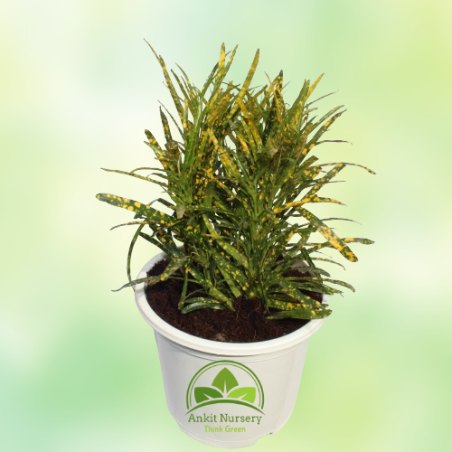
- -10%






The Gold Dust Croton plant (Codiaeum variegatum 'Gold Dust') is a popular and colorful houseplant known for its striking foliage. Gold Dust Crotons thrive in bright, indirect light. They need at least 4-6 hours of sunlight per day to maintain their vibrant foliage colors. Avoid direct sunlight, as it can scorch the leaves.
Keep the plant in a warm environment with temperatures between 60-80°F (16-27°C). Avoid exposing it to cold drafts or sudden temperature fluctuations. Water the plant thoroughly when the top inch of soil feels dry to the touch, allowing excess water to drain away. Crotons prefer slightly moist soil but are susceptible to root rot if overwatered. Reduce watering during the winter months when growth slows down.
Gold Dust Crotons prefer high humidity levels. You can increase humidity by misting the leaves regularly, placing a humidifier nearby, or grouping the plant with other moisture-loving plants. Use well-draining potting soil with plenty of organic matter. A mix formulated for tropical plants or houseplants works well.
Feed your Gold Dust Croton with a balanced liquid fertilizer diluted to half strength every 4-6 weeks during the growing season (spring and summer). Reduce fertilization in fall and winter when growth slows down. Prune the plant regularly to maintain its shape and remove any dead or leggy growth. You can also pinch back new growth to encourage bushier growth. Gold Dust Crotons can be propagated from stem cuttings. Take a cutting with several nodes, remove the lower leaves, and place it in a pot with moist potting mix. Keep the soil consistently moist until roots develop.
Gold Dust Crotons are toxic to humans and pets if ingested, so keep them out of reach of children and animals.
Watch out for common houseplant pests like spider mites, aphids, and mealybugs. If you notice any signs of infestation, treat the plant with insecticidal soap or neem oil. With proper care, your Gold Dust Croton can thrive and bring vibrant color to your indoor space. Enjoy its beautiful foliage and watch it grow!
Dracaena is a genus of tropical plants known for their attractive foliage and low maintenance...
Kagzi Grafted Lemon Plant, also known as Citrus limon 'Kagzi' or 'Kagzi Nimbu,' is a popular...
Spider Plant (Chlorophytum) scientifically known as Chlorophytum comosum, are popular...
The Schefflera plant, often referred to as the Umbrella Tree or Schefflera arboricola, is a...
It appears you may be referring to the "Dieffenbachia" plant, often misspelled as...
Dracaena marginata, commonly known as the Dragon Tree or Madagascar Dragon Tree, is a popular...
The "Croton Yellow" plant likely refers to a variety of Croton (Codiaeum variegatum) with...
The term "Syngonium Golden" likely refers to a variety of Syngonium plant with golden or...
The Philodendron Florida is a beautiful and relatively rare cultivar of Philodendron known for...
The Snake Plant, scientifically known as Sansevieria trifasciata (formerly classified under...
Ferns are a diverse group of plants known for their delicate, feathery foliage and are...
Cyperus alternifolius, commonly known as Umbrella Palm, is a popular plant species native to...
Rubber Plant - White Pot is a popular and attractive houseplant known for its glossy, deep...
The "Golden Xanadu" is a cultivar of the Philodendron plant, known scientifically as...
The green money plant, also known as Epipremnum aureum or Devil's Ivy, is a popular indoor...
Aglaonema Snow White, also known as Aglaonema 'Snow White,' is a specific cultivar of the...